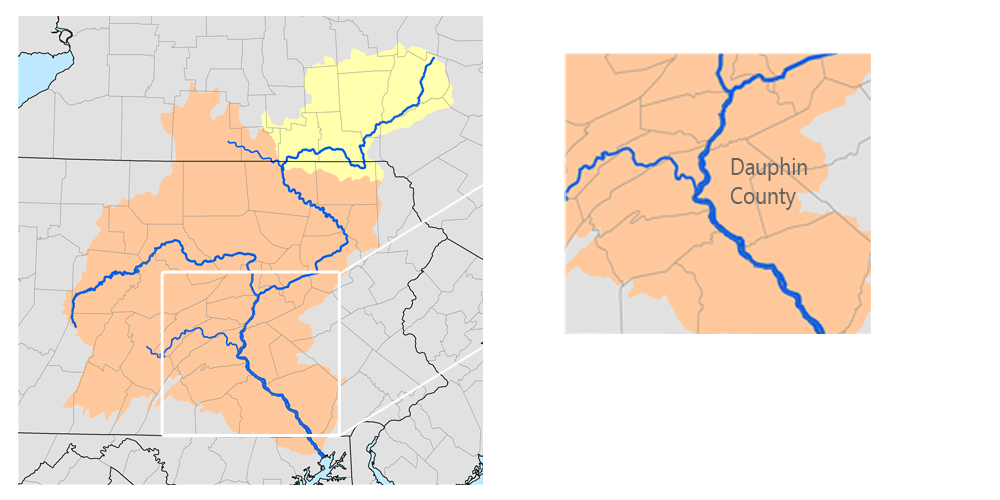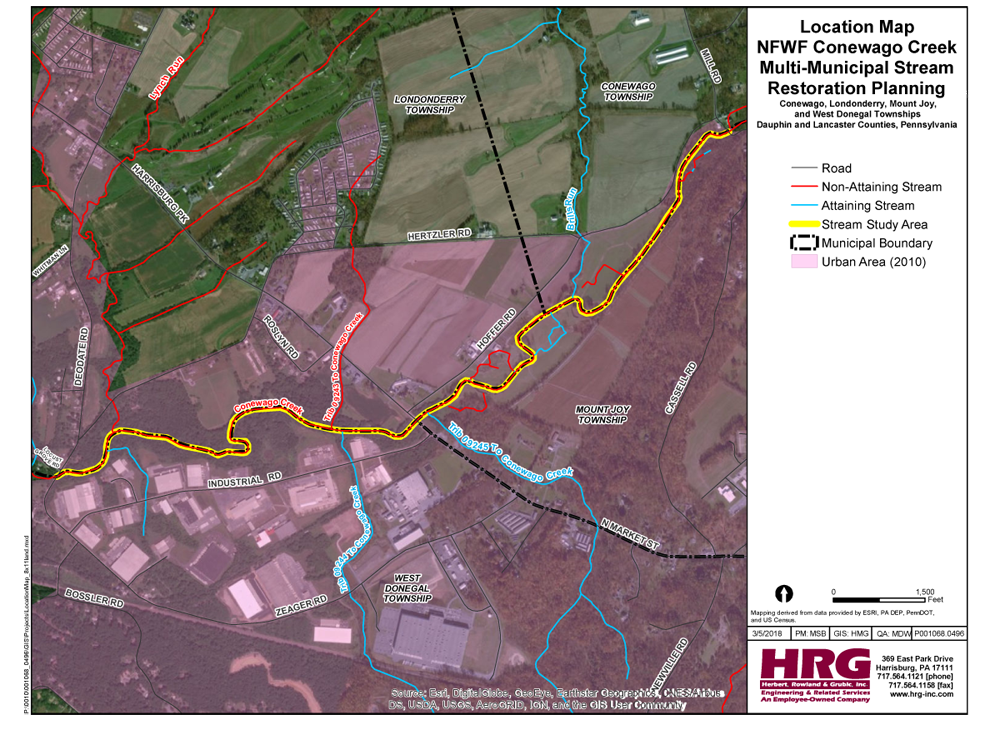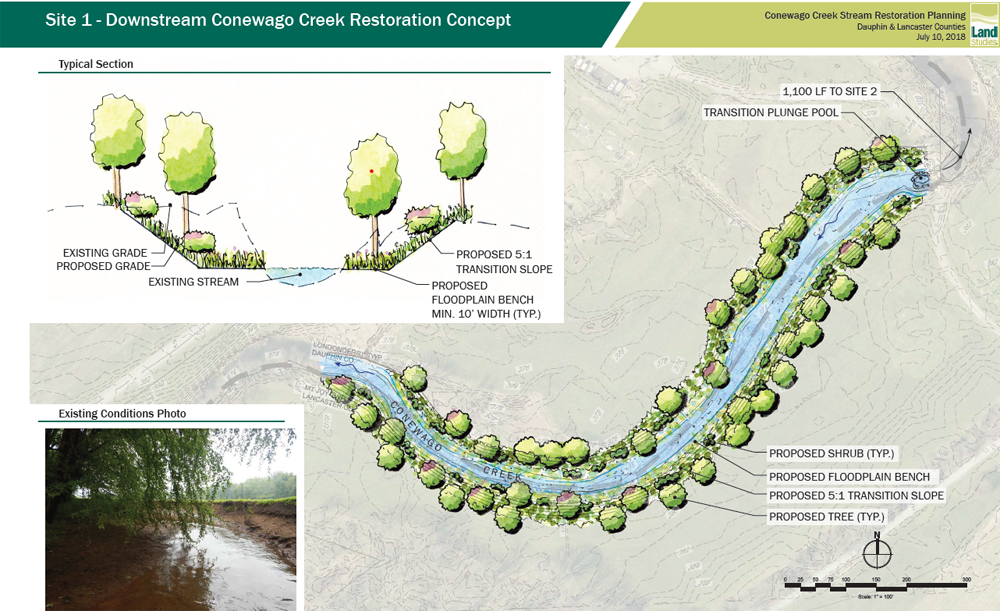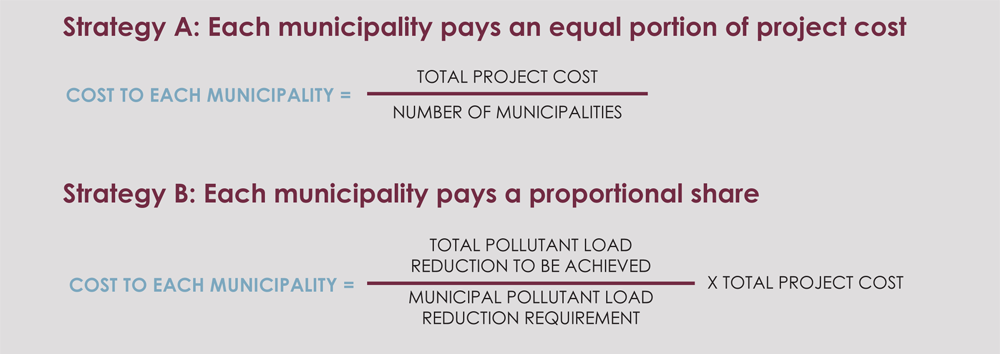Municipalities face increasing regulation of water quality through MS4 permit requirements as that permitting program has evolved. These requirements represent an unfunded mandate that squeezes tight municipal budgets. Local officials want to improve local water quality for their constituents, but they have limited funds to do it when compared to other vital services they provide. Therefore, they need to select projects that will provide the greatest value for the lowest possible cost to provide the greatest pounds of pollutant removal per dollar spent.
Many communities are exploring the option of intergovernmental cooperation to make that happen. Londonderry and Mount Joy Townships are two of these communities.
CHALLENGE
Reduce pollution cost-effectively in an impaired watershed that is subject to a TMDL plan from the Pennsylvania Department of Environmental Protection
Like many municipalities in Pennsylvania, Londonderry and Mount Joy Townships share a waterway as their border: The Conewago Creek. This creek is an impaired waterway that is heavily impacted by excess sediment and nutrient loading related to agricultural activities. The Pennsylvania Department of Environmental Protection (PA DEP) has developed a Total Maximum Daily Load (TMDL) Plan for the creek, which means any Municipal Separate Storm Sewer System (MS4) that drains to the creek must reduce pollution in order to meet a targeted wasteload allocation. (For more information on the Total Maximum Daily Load (TMDL) Plan, visit PA DEP’s website or https://bit.ly/39qyN2t)
The Conewago Creek drains into the Susquehanna River, one of the longest rivers in America. The Susquehanna River provides over half of the freshwater to the Chesapeake Bay, drinking water to millions of people along its full length, aquatic recreational opportunities, and scenic views. For these and many other reasons (the reintroduction of American Eel and other species to the creek), the river is a valued natural and economic resource to this region.
Conewago Creek, via the Susquehanna River, eventually drains to the Chesapeake Bay, which is a highly regulated water body with significant pollutant reduction requirements of its own. This particular section of the creek where Londonderry and Mount Joy meet is designated a trout stocked fishery (TSF) and is located within a National Fish and Wildlife Federation Eastern Brook Trout habitat priority watershed.
Map of the Susquehanna River Watershed
The need to reduce pollution generated by the watershed is well-established and well- regulated. Both municipalities had to create a pollution reduction plan as part of their MS4 permit for the 2018-2023 permit cycle. This plan requires a 10% reduction in total suspended solids loading for MS4 communities in the Chesapeake Bay drainage area. Achieving pollution reduction goals cost-effectively is the challenge.
SOLUTION
Cooperate across municipal borders to produce the best possible results at a lower individual cost
Within the state of Pennsylvania, there are over 2,500 municipalities, many that have streams as the border line between jurisdictions. Stream restoration projects have the potential to provide major sediment reduction benefits at a reasonable cost. However, they can not be fully effective if the restoration only addresses one side of the stream. PA DEP awards significant pollutant reduction credits for stream restoration projects, so this type of Best Management Practice (BMP) is very attractive to municipalities looking to meet their permit-required load reductions as cost-effectively as possible. However, not all stream restoration projects are eligible for these credits, and the power to determine eligibility rests with PA DEP. The criteria they have set forth specifically states that stream restoration projects must address both sides of the stream channel where the need is evident, and the project must take a comprehensive approach to address the full scope of issues causing erosion in order to ensure the long-term stability of the stream channel. If a stream is the boundary for multiple municipalities – as Conewago Creek is – municipal cooperation is almost certainly necessary to receive pollutant reduction credit from PA DEP.
Still, many local government officials are wary of intergovernmental cooperation. They do not want to lose their decision-making authority, and they want to protect themselves from liability they cannot control. They also want to make sure every partner pays its fair share and obtains proportional credit.
Cooperation on MS4 pollutant reduction projects is particularly concerning to local officials because regulatory agencies have not issued much guidance on how cooperation can be done, who will get credit, and who will ultimately be responsible for maintenance and compliance. However, this regulatory guidance is improving. In the most recent MS4 permit cycle, PA DEP began to encourage cooperation on watershed-level pollutant reduction projects and is working to make the process more transparent for local officials.
Regardless of the type of project municipalities choose to take on, successful collaboration requires all parties to achieve consensus. They must agree on how the project need should be defined. They must also agree on the proper approach to addressing the project need, and they must agree on the most equitable way to share costs. In other words, they need to agree on what goals the project must achieve, the best way to accomplish those goals, and how much each party will pay for the effort.
Open communication is crucial. In the case of Londonderry and Mount Joy Townships, both municipal managers regularly attended stakeholder group meetings where these issues were honestly discussed and negotiated. The Conewago Creek watershed already had a group of stakeholders that met regularly to discuss local water quality issues. Known as the Conewago Creek Initiative, the group is led by the local Penn State Extension office, and it has provided valuable insight on other upstream restoration projects and existing site conditions. It has also assisted in defining the project scope, developing funding applications, and reaching out to private landowners.
When stream restoration projects are conducted on private property, partnership with local landowners is critical. No projects can be implemented without easements from these landowners. During development of the Conewago Creek stream restoration project, municipal representatives met with adjacent property owners to discuss the goals of the project and the impact it would have on their property. This was an important step because these landowners had to sign legal agreements stating they were agreeable to having a stream restoration project completed on their property as part of the funding application process and to agree to operation and maintenance access.
Other stakeholders that municipalities should include in a collaborative stream restoration project include watershed organizations, non- profit groups and educational institutions that have a vested interest in local waterways. These groups can provide valuable knowledge to improve the outcome of the project, and they can use their platform to garner public support for any proposed improvements. They can also provide letters of support for any funding applications municipalities may be applying for.
Based on the input these stakeholders provided, Londonderry and Mount Joy Townships set about defining the project need.
Defining the Project Need
Before this project began, Londonderry and Mount Joy Townships knew Conewago Creek suffered from extensive sediment pollution. Both municipalities had independently identified the same reach of the creek as being in need of stream restoration in their Chesapeake Bay Pollutant Reduction Plans (CBPRPs). Each municipality had observed several conditions that indicated the need for restoration, including minimal riparian buffer width, instream accumulation of sediment deposits, stream turbidity, and incised stream banks. In addition, PA DEP had identified Conewago Creek as an impaired waterway in its 2016 Integrated Water Quality Report.
The municipalities collaborated on a stream assessment to:
- Verify that the project area meets eligibility criteria for MS4 pollutant reduction credits.
- Collect data to inform the design process.
- Fully document existing conditions in order to later maximize pollutant load reduction credits. (By conducting a formal stream assessment, professionals were able to calculate a site-specific erosion rate. This data showed the sediment removal rate a restoration project could achieve was much higher than the standard value provided by PA DEP for credit calculation.)
- Evaluate the flood mitigation impact potential of the project.

Due to the high degree of variability in assessment parameters, stream assessments should be performed by a qualified professional and be conducted using a verified method (BANCS or equal).
In the case of the Conewago Creek stream assessment, a team of qualified professionals from Land Studies, Inc., walked the stream channel, measured bank heights, recorded flow depths, noted vegetative conditions, and installed bank pins to measure erosion rates. Professionals also surveyed the assessed stream reach to measure bank heights and channel depths. Engineers at Herbert, Rowland & Grubic, Inc. (HRG) then used this empirical data to develop hydraulic models of the stream channel and pinpoint the highest priority areas in need of restoration.
Scientific data like this ensures that all parties in a collaborative arrangement are working from the same set of facts about current site conditions and potential improvements. It can also help position communities for additional funding opportunities by leveraging existing funds. Londonderry and Mount Joy Townships used the data from their stream assessment and survey to successfully obtain over $1 million dollars in funding from the Mariner II East Pipeline Assessment Fund and PA DEP’s Growing Greener program. Many other funding opportunities are available for water quality improvements, so be sure to review all options. Municipalities considering stream restoration projects should work with a consultant who is familiar with funding program eligibility, timelines, and match requirements, so that they can take full advantage of these programs, as Londonderry and Mount Joy Townships were able to do.
Selecting the Right Approach
HRG utilized the data from the stream assessment and survey to determine projects that could restore the stream channel to its natural, stable dimensions, and re-establish processes that reduce erosion capture pollutants and reduce flooding potential. The next step included working with the participating municipalities and the various stakeholders to review the potential project list and prioritize those that could provide the maximum benefit and garner the necessary community support.
The approach that was developed will create a stable, low-lying floodplain bench with adjacent banks graded at a shallow slope and stabilized with extensive native plant cover. This floodplain bench will create a low bank height for the stream. During high- flow events, the floodplain bench will allow increased flows to escape the channel and access the additional flood storage provided by the restoration area, greatly reducing flow velocity by spreading the volume of water over a greater surface area. This additional flow area will mitigate otherwise potentially erosive flow conditions and reduce the potential of severe flooding downstream.
The approach provides additional capacity for flood flows and reduces erosive energy in the channel while minimizing the impact to adjacent agricultural fields. Thanks to the available increased flood storage, adjacent farms will be inundated less frequently, keeping valuable seed and nutrients on the field (and out of the creek).
With the right approach identified, the conceptual designs were prepared, and project costs were developed (along with the corresponding pollutant load reductions). Finally, the municipalities begin utilizing this information to guide the negotiations on how to share project costs and credit equitably.
View more concepts of potential Conewago Creek restoration projects:
Download the full Conewago Creek Case Study for Municipal Cooperation on MS4 Compliance and Watershed Management
Deciding How to Share Costs and Credit Equitably
When collaborating on a stream restoration project, two ways municipalities can choose to share the cost are evenly or proportionally. In other words, each municipality can pay an equal share of the total project cost, or it can pay an amount that is proportional to the pollutant load reduction credit it will receive from the project and the risk assumed by each.
For example, let’s say two municipalities implemented a project with a pollutant load reduction benefit of 10,000 pounds of total suspended solids removal per year (lbs/TSS/ year) at a cost of $200,000. Under Strategy A, both municipalities would pay $100,000 and report an achieved pollutant load reduction of 5,000 lbs/TSS/year in their MS4 Annual Reports. This approach works well when each municipality has a similar pollutant load reduction requirement. However, if one municipality is only required to reduce pollutant loads by 2,500 lbs/TSS/year, and the other municipality is required to reduce pollutant loads by 7,500 lbs/TSS/year, Strategy B would be a more equitable way of allocating costs and credits. The municipality with the lower pollutant load reduction requirement would pay only 25% of the total project cost ($50,000) and receive 25% of the pollutant load reduction credit (2,500 lbs/TSS/year) in its MS4 Annual Report.
A qualified consultant with dual expertise in MS4 compliance and municipal finance can help municipalities negotiate a fair agreement that distributes costs equitably. Once agreed upon, this consultant can finalize the cost- sharing formula in a formal inter-governmental agreement.
In the case of Londonderry and Mount Joy Townships, this final negotiated cost share was completed once the final design of the stream restoration was finished in the spring of 2020.
Download the full Conewago Creek Case Study for Municipal Cooperation on MS4 Compliance and Watershed Management to see:
- Existing and proposed hydraulic models of the creek
- Visual concepts of potential stream restoration projects
Advice for Municipalities Who Want to Collaborate on MS4 Pollutant Load Reduction Projects
Many municipalities face rising costs associated with MS4 compliance, but funding has not risen to the necessary level to address this growing need. The competition for available funding to offset these costs is high and cooperation across municipal borders can give a competitive edge when applying. Cooperation with neighboring municipalities can help communities meet their regulatory obligation at a lower cost, so it is an increasingly attractive option.
Working together can help municipalities tackle larger, more impactful projects. It can also help them share certain fixed costs of permitting and lower the cost of construction by combining all necessary improvements into one bid agreement. Regional projects that benefit more than one community are also more likely to receive support from partnering non-profit organizations and academia.
In many cases, cooperation is not just beneficial; it is necessary to truly improve water quality. Stream restoration projects like the one undertaken by Londonderry and Mount Joy Townships are particularly effective at reducing sediment pollution, but they are only eligible for MS4 pollutant load reduction credits if they provide a comprehensive solution to the issues causing erosion. This is highly unlikely if the stream serves as a border to multiple municipalities, and those municipalities do not work together on a solution.
Still, cooperation can be un-settling to many local officials. Regulatory agencies have, so far, provided minimal guidance about how municipalities can share costs and credit for collaborative pollutant load reduction initiatives. Without defined guidance in place, many municipalities have been hesitant to be the first ones to push forward with this endeavor and define the process for others to follow.
Londonderry and Mount Joy Townships’ efforts to date provide a template municipalities can follow when attempting their own collaborative projects. Following their example, municipalities can improve their chance of success by working with a consultant that has dual expertise in MS4 compliance and municipal finance. This consultant can help them navigate complicated regulatory requirements and determine the most effective projects to maximize credits and minimize costs. The consultant can also help them determine a formula for sharing costs and credit equitably and formalize the details in a legal inter-municipal agreement.
Throughout the project, municipalities should strive for open and honest communication, as Londonderry and Mount Joy Townships did with regular stakeholder group meetings. These meetings included the input of local landowners, watershed organizations, non- profits, and educational institutions that care about local water quality.
Using a scientific approach and considering the input of the entire community, Londonderry and Mount Joy Townships were able to develop a project that returns the stream to its natural, stable dimensions and re-establishes processes that reduce erosion and capture pollutants. This solution reduces pollution today and ensures long-term stability of the stream far into the future, providing maximum value to both communities. It also helps improve local aquatic habitat to support and improve wildlife habitat, in addition to reducing flood impacts in the watershed.
Lessons Learned
Based on HRG’s experience, the biggest lessons learned would be:
Routine meetings with stakeholders throughout the process helps to ensure collaboration towards achieving common goals. Often, individual side projects could provide benefit to the joint project, and routine meetings become a good mechanism to capitalize on those synergies. The Conewago Creek Initiative meets every other month and includes representatives from the major stakeholders.
Each municipality must have a project champion. This champion must be motivated and organized and willing to communicate the needs of their respective municipality to the group and also keep the elected officials informed.
For projects where one of the project partners is not the landowner, communication through the process to obtain written commitments is vital. We had an instance where there was a landowner transition due to a real estate sale during the planning process. The current owner helped negotiate the commitments made with the new owner to get their buy- in and eventually get the landowner agreement signed and in place.
Grant funding has been vital to getting this project conceptualized and designed. It will also prove vital through the permitting and construction phases.






